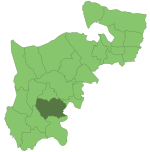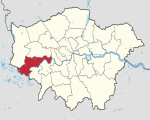Hounslow East tube station
Former Metropolitan District Railway stationsLondon Underground Night Tube stationsPiccadilly line stationsRail transport stations in London fare zone 4Railway stations in Great Britain opened in 1909 ... and 2 more
Tube stations in the London Borough of HounslowUse British English from August 2012

Hounslow East is a London Underground station in Hounslow in west London designed by Acanthus LW Architects. The station is on the Heathrow branch of the Piccadilly line, between Hounslow Central and Osterley. The station is located on Kingsley Road about 400m north of Hounslow High Street. Hounslow Bus Garage (the main bus terminus) is a short walk to the south. It is in Travelcard Zone 4.
Excerpt from the Wikipedia article Hounslow East tube station (License: CC BY-SA 3.0, Authors, Images).Hounslow East tube station
Stirling Grove, London Lampton (London Borough of Hounslow)
Geographical coordinates (GPS) Address Nearby Places Show on map
Geographical coordinates (GPS)
| Latitude | Longitude |
|---|---|
| N 51.473 ° | E -0.3563 ° |
Address
Stirling Grove
Stirling Grove
TW3 1QG London, Lampton (London Borough of Hounslow)
England, United Kingdom
Open on Google Maps





